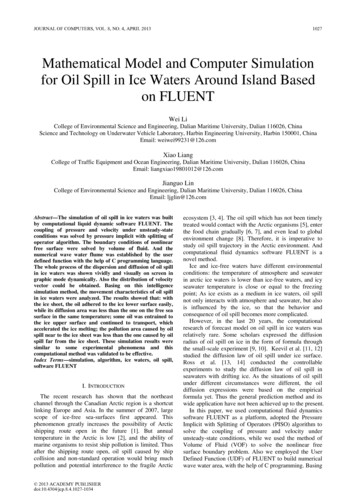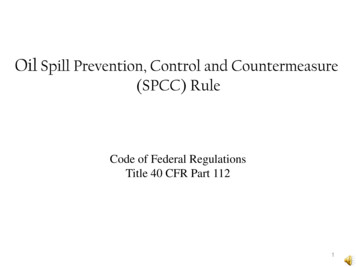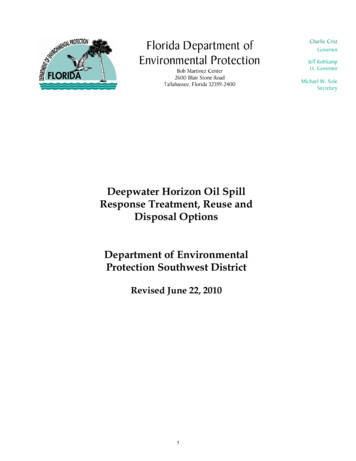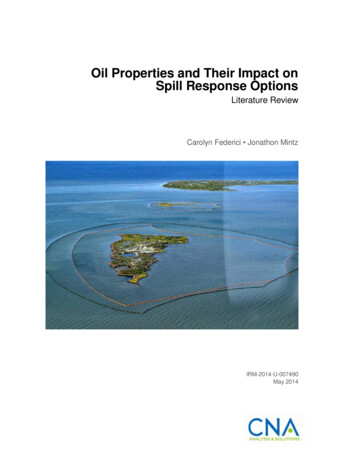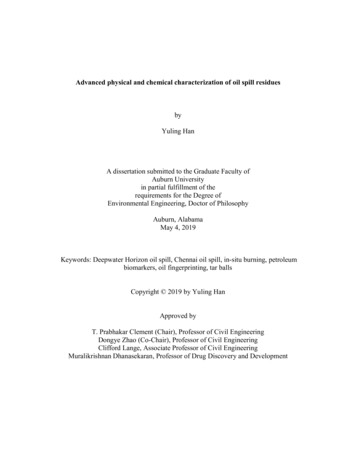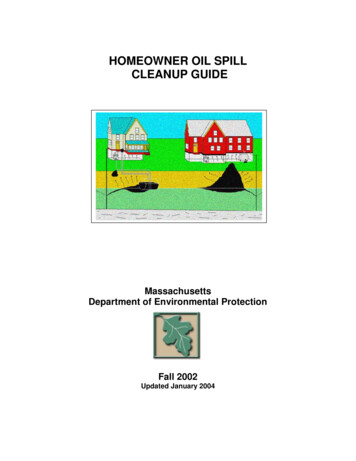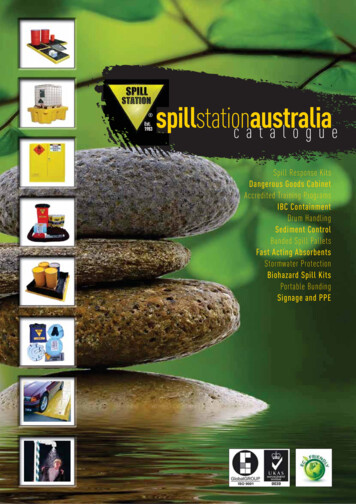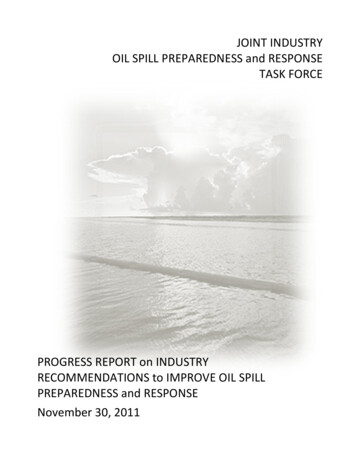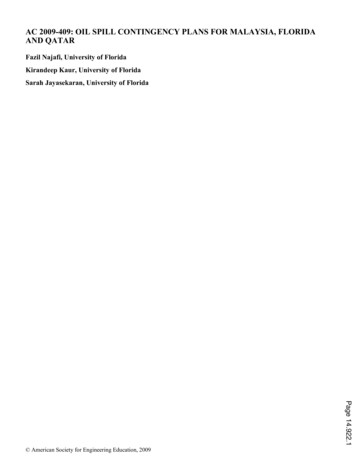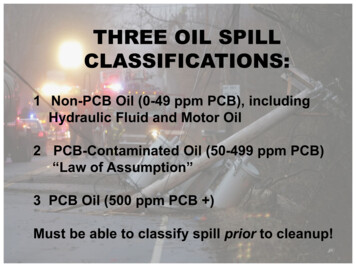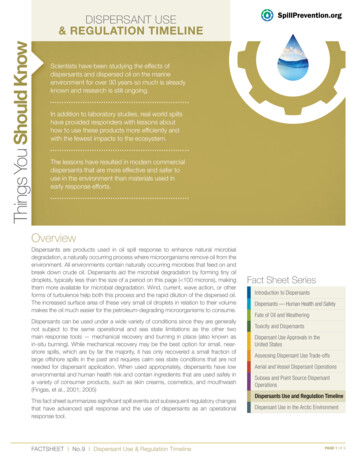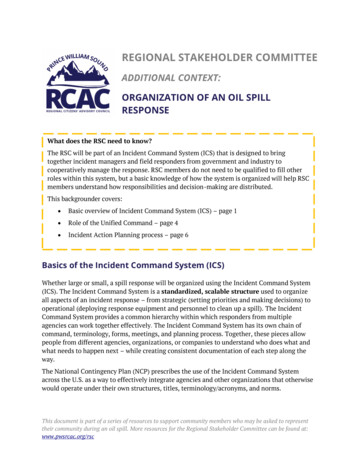
Transcription
REGIONAL STAKEHOLDER COMMITTEEADDITIONAL CONTEXT:ORGANIZATION OF AN OIL SPILLRESPONSEWhat does the RSC need to know?The RSC will be part of an Incident Command System (ICS) that is designed to bringtogether incident managers and field responders from government and industry tocooperatively manage the response. RSC members do not need to be qualified to fill otherroles within this system, but a basic knowledge of how the system is organized will help RSCmembers understand how responsibilities and decision-making are distributed.This backgrounder covers: Basic overview of Incident Command System (ICS) – page 1 Role of the Unified Command – page 4 Incident Action Planning process – page 6Basics of the Incident Command System (ICS)Whether large or small, a spill response will be organized using the Incident Command System(ICS). The Incident Command System is a standardized, scalable structure used to organizeall aspects of an incident response – from strategic (setting priorities and making decisions) tooperational (deploying response equipment and personnel to clean up a spill). The IncidentCommand System provides a common hierarchy within which responders from multipleagencies can work together effectively. The Incident Command System has its own chain ofcommand, terminology, forms, meetings, and planning process. Together, these pieces allowpeople from different agencies, organizations, or companies to understand who does what andwhat needs to happen next – while creating consistent documentation of each step along theway.The National Contingency Plan (NCP) prescribes the use of the Incident Command Systemacross the U.S. as a way to effectively integrate agencies and other organizations that otherwisewould operate under their own structures, titles, terminology/acronyms, and norms.This document is part of a series of resources to support community members who may be asked to representtheir community during an oil spill. More resources for the Regional Stakeholder Committee can be found at:www.pwsrcac.org/rsc
Command StaffGeneral StaffFigure 1: Key functions of Command and General staff in the Incident Command SystemThe Incident Command System is scalable to different sized incidents. In a small incident, allroles could be filled by just a few people. A large incident could involve hundreds. Regardless,ICS personnel are generally organized in two categories: Command Staff are direct advisors to Unified Command and include the PublicInformation, Safety, and Liaison Officer(s). This is the level at which RSC processes willbe taking place with the RSC members having direct access to the Unified Command fora limited time each day. General Staff are the positions that report directly to the Unified Command, which areorganized in four Sections as shown in Figure ationSections may be divided into one or more Branches, Divisions, Groups, Units, TaskForces, and Strike Teams.Figure 2 shows what the Incident Command System for a large oil spill response may look like.www.pwsrcac.org/rsc2
Figure 2: Example of fully developed ICS organization for a large oil spill response (U.S. CoastGuard Field Operations Guide for Oil Spill Response)FOR MORE INFORMATION:Federal Emergency Management Agency ICS trainingshttps://training.fema.gov/nims/U.S. Coast Guard Incident Management c.org/rsc3
Role of the Unified CommandA Unified Command structure is used to oversee a spill when more than one agency hasjurisdiction. Unified Command brings multiple responsible agencies together to manage anincident by establishing a common set of incident objectives and strategies. The UnifiedCommand then directs the response through a joint decision-making process.Unified Command is made up of On-Scene Coordinators (OSC) from impacted jurisdictions.Depending on the affected area, these may include: Federal On-Scene Coordinator (FOSC) – Representative from the U.S. Coast Guard formarine and coastal spills, typically the Captain of the Port for a given Port Zone; theEnvironmental Protection Agency for inland spills; or the Department of Defense foranything related to the military. State On-Scene Coordinator (SOSC) – Representative of the Alaska Department ofEnvironmental Conservation (ADEC). Responsible Party On-Scene Coordinator (RPOSC) – Employee of or contractor hiredby the company responsible for the oil spill, known as the "Responsible Party," oftenabbreviated simply as “RP.” Local On-Scene Coordinator (LOSC) – Representative of the local government(s).There is typically a LOSC only when there is an immediate threat to the health andsafety of a local population and/or the incident occurs within their jurisdiction. After animmediate public health threat has passed, the LOSC may transition to the RSC. Tribal On-Scene Coordinator (TOSC) – Representative of Tribal government(s)impacted by a spill. Similar to the LOSC, there may not be a TOSC for every spill.The authority to assign an On-Scene Coordinator to the Unified Command is derived fromresponse plans, laws, and regulations.Within the Unified Command, there will be a single Incident Commander who directs thecontrol, containment, removal, and disposal of the spill. In most cases, the IncidentCommander (IC) is the Responsible Party On-Scene Coordinator, unless the Responsible Partyis unknown, unwilling, or unable to fulfill their responsibilities. In this case, the Federal OnScene Coordinator or State On-Scene Coordinator may assume the role of IncidentCommander. The Local On-Scene Coordinator may also assume this role as long as there is animmediate threat to public safety in their jurisdiction.www.pwsrcac.org/rsc4
Role of Local On-Scene Coordinator vs. RSCUnderstanding the difference between Unified Command and RSC roles is important for local orTribal governments with an interest in spill response and should be discussed in localemergency response plans.The table below outlines basic differences between a Unified Command role and RSCmembership based on the regional and area contingency plans.Considerations forAssigning CommunityRepresentativesLocal or Tribal On-SceneCoordinator (LOSC/TOSC)RSC MemberImpact to CommunityImmediate threat to publichealth and safety from oilspillPotential ecological orcultural resource impacts,but no immediate threat topublic health/safetyLevel of Authority overIncident ResponseParticipate in UnifiedCommand responsedecision-making, includingsetting priorities anddirecting resourcesProvides input to UnifiedCommand through LiaisonOfficer but no direct role insetting priorities anddirecting resourcesIncident Action Plan (IAP)Development and ReviewAs part of UnifiedCommand, responsible forreviewing and signing off oneach IAP during PlanningMeetingReviews IAP once it issigned off and providesfeedback or input to UnifiedCommand through LiaisonOfficer for next IAPConnection to andCoordination withCommunity/ConstituentsAccountable to senioradministrative officials ingovernment or tribe, andmay coordinate incidentresponse with local/tribalEmergency OperationsCenter if activatedProvide informationalupdates to communityleaders or in-communityliaisons and conveycommunity concerns andpriorities back to UnifiedCommand through LiaisonOfficerwww.pwsrcac.org/rsc5
Incident Action Planning (IAP) ProcessOperational Periods and the "Planning P"The Incident Command System uses operational planning cycles, which defines a schedule ofmeetings and the development of the Incident Action Plan, starting with the initial response.This process is often shown in a "Planning P" that begins with initial response steps thathappen only once, then enters a "loop" that repeats until the response has concluded.Initial response steps happen only once during the earliest phase of the response, when partiesare being notified and are beginning to form the Incident Command System response structure.The “loop” in the P is a process that repeats for the duration of the response. Operationalperiods are typically shorter (12 -24 hours) in the beginning of the event when the situation ismost dynamic. As the response matures, operational periods may lengthen to 24 hours or evendays or weeks.There are many versions of this Planning P diagram; the one shown here is from the U.S. CoastGuard’s Incident Management Handbook.www.pwsrcac.org/rsc6
Incident Action Plan (IAP)The Incident Action Plan (IAP) is the key document produced within Incident CommandSystem that summarizes the response and describes the next steps. An IAP is produced for eachoperational period to summarize the response status and outline priorities for future responseoperations. Together, these various forms tell the story of what is happening and why. RSCaccess to the Incident Action Plan is assured under the Alaska Regional Contingency Plan andPrince William Sound Area Contingency Plan.The Incident Action Plan itself is an important snapshot of the incident status and also createsa simultaneous record of key response decisions; however, RSC members will be most effectiveif they focus on providing input into the Incident Action Plan development process before theplan is finalized. RSC members may be interested in different aspects of the Incident ActionPlan depending upon the priorities and concerns of their constituents and the progression ofthe oil spill and cleanup operations.The Incident Action Plan is developed based on a set of standard Incident Command Systemforms. While RSC members do not need to know all the names and numbers of IncidentCommand System forms, it is useful to have some familiarity with the forms that make up theIncident Action Plan. In addition to the forms, other plans and procedures may be included asneeded (e.g., Waste Management Plan, Shoreline Cleanup and Assessment Team Plan, WildlifeProtection Plan). Incident Command System personnel may refer to forms by their name ornumber interchangeably.If there are questions on terminology or other information on these forms, ask the LiaisonOfficer to review this information.www.pwsrcac.org/rsc7
Core components of the Incident Action PlanICS Form s the basic incident strategy, incident objectives,command emphasis/priorities, and safetyconsiderations for use during the next operationalperiod.ICS-203OrganizationAssignment ListIdentifies the ICS positions and units that are active andthe individuals staffing each position.ICS-207ICS OrganizationChartProvides a visual organization chart that identifies ICSassignments and may be printed as a poster and wallmounted.ICS-204Assignment ListIdentifies resource and work assignments to accomplishincident s radio channel assignments.ICS-206Medical PlanProvides information on medical aid stations andemergency services.n/aIncident Mapand Chart(s)Maps and charts showing clean-up operations and otherinformation.n/aWeather andTide ForecastsInformation on conditions and tides relevant to theclean-up operation.www.pwsrcac.org/rsc8
Additional (optional) components of the IAPICSForm #TitleDescriptionICS202aCommand DirectionSupplement the Incident Objectives (ICS-202) form withadditional strategic direction and information needs tosupport incident objectives.andICS202bandCritical InformationRequirementsICS-208Site Safety andHealth PlanPlan to ensure safety and health of response personnel.ICS-209Incident StatusSummarySummary of information about spill volume, wildlife andshoreline impacts, waste recovered, resources, andpersonnel. This form receives frequent updates.ICS-220Air OperationsSummarySummary of air operations assignments and activities ifthey are ongoing.ICS-232Resources-at-RiskSummaryIdentifies species and habitat that may be present nearthe spill and/or potentially impacted by the spill or theresponse.n/aDemobilization PlanPrepared for certain resources or response functions asneeded when a resource/function is released.n/aTransportation PlanPlan for transporting field teams to different sites.n/aDecontaminationPlanPlan for cleaning contaminated equipment and resourcesin between assignments or prior to their release.n/aWaste Managementor Disposal PlanPlan for managing liquid and solid waste streams that aregenerated during a response.n/aInformationManagement PlanDescribes how information flows internally and externally.n/aVolunteerManagement PlanHow volunteers – who are likely to just show up - will bemanaged and assigned to support the response.www.pwsrcac.org/rsc9
FOR MORE INFORMATION:U.S. Coast Guard Incident Command System forms and ICS-Forms/Example Incident Action Plan from the M/V Selendang Ayu oil spill in theAleutian Islands in 4656811992d3eae93901293d22fab340e653c76/Incident Action Planning Guide Revision1.pdfwww.pwsrcac.org/rsc10
Basics of the Incident Command System (ICS) Whether large or small, a spill response will be organized using the Incident Command System (ICS). The Incident Command System is a standardized, scalable structure used to organize all aspects of an incident response - from strategic (setting priorities and making decisions) to
